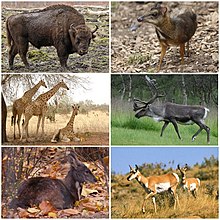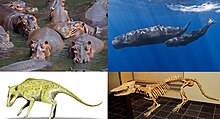Cetruminantia
| Cetruminantia Temporal range: | |
|---|---|
 | |
 | |
| Scientific classification | |
| Domain: | Eukaryota |
| Kingdom: | Animalia |
| Phylum: | Chordata |
| Class: | Mammalia |
| Order: | Artiodactyla |
| Clade: | Artiofabula |
| Clade: | Cetruminantia Waddell et al. 1999 |
| Subgroups | |
The Cetruminantia are a clade made up of the Cetancodontamorpha (or Whippomorpha) and their closest living relatives, the Ruminantia.[1]
Cetruminantia's placement within Artiodactyla can be represented in the following cladogram:[2][3][4][5][6]
| Artiodactyla |
| ||||||||||||||||||||||||
Classification[edit]
- Order Artiodactyla (even-toed ungulates)
- Tylopoda (camelids)
- Artiofabula (ruminants, pigs, peccaries, whales, and dolphins)
- Suina (pigs and peccaries)
- Cetruminantia (ruminants, whales, and dolphins)
- Suborder Ruminantia (antelope, buffalo, cattle, goats, sheep, deer, giraffes, and chevrotains)
- Family Antilocapridae (pronghorn)
- Family Bovidae, 135 species (antelope, bison, buffalo, cattle, goats, and sheep)
- Family Cervidae, 55~94 species (deer, elk, and moose)
- Family Giraffidae, 2 species (giraffes, okapis)
- Family Moschidae, 4~7 species (musk deer)
- Family Tragulidae, 6~10 species (chevrotains, or mouse deer)
- Suborder Whippomorpha (aquatic or semi-aquatic even-toed ungulates)
- Infraorder Acodonta
- Family Hippopotamidae, 2 species (hippopotamuses)
- Infraorder Cetacea (whales, dolphins, and porpoises)
- Mysticeti (baleen whales)
- Family Balaenidae, 2~4 species (right whales and bowhead whales)
- Family Balaenopteridae, 6~9 species (rorquals)
- Family Eschrichtiidae, 1 species (gray whale)
- Family Neobalaenidae, 1 species (pygmy right whale)
- Odontoceti (toothed whales, dolphins, and porpoises)
- Superfamily Delphinoidea (dolphins, arctic whales, porpoises, and relatives)
- Family Delphinidae, 38 species (dolphins, killer whales, and relatives)
- Family Monodontidae, 2 species (beluga and narwhal)
- Family Phocoenidae, 6 species (porpoises)
- Superfamily Physeteroidea (sperm whales)
- Family Kogiidae, 2 species (pygmy and dwarf sperm whales)
- Family Physeteridae, 1 species (common sperm whale)
- Superfamily Ziphoidea (beaked whales)
- Family Ziphidae, 22 species (modern beaked whales)
- Superfamily Platanistoidea (river dolphins)
- Family Iniidae, 1~3 species (South American river dolphin(s))
- Family Lipotidae, 1 species (baiji or Chinese river dolphin)
- Family Platanistidae, 1~2 species (Asian river dolphin(s))
- Family Pontoporiidae, 1 species (La Plata dolphin)
- Superfamily Delphinoidea (dolphins, arctic whales, porpoises, and relatives)
- Mysticeti (baleen whales)
- Infraorder Acodonta
- Suborder Ruminantia (antelope, buffalo, cattle, goats, sheep, deer, giraffes, and chevrotains)
References[edit]
- ^ A higher-level MRP supertree of placental mammals
- ^ Beck, N.R. (2006). "A higher-level MRP supertree of placental mammals". BMC Evol Biol. 6: 93. doi:10.1186/1471-2148-6-93. PMC 1654192. PMID 17101039.
- ^ O'Leary, M.A.; Bloch, J.I.; Flynn, J.J.; Gaudin, T.J.; Giallombardo, A.; Giannini, N.P.; et al. (2013). "The placental mammal ancestor and the post-K-Pg radiation of placentals". Science. 339 (6120): 662–667. doi:10.1126/science.1229237. hdl:11336/7302. PMID 23393258. S2CID 206544776.
- ^ Song, S.; Liu, L.; Edwards, S.V.; Wu, S. (2012). "Resolving conflict in eutherian mammal phylogeny using phylogenomics and the multispecies coalescent model". Proceedings of the National Academy of Sciences. 109 (37): 14942–14947. doi:10.1073/pnas.1211733109. PMC 3443116. PMID 22930817.
- ^ dos Reis, M.; Inoue, J.; Hasegawa, M.; Asher, R.J.; Donoghue, P.C.J.; Yang, Z. (2012). "Phylogenomic datasets provide both precision and accuracy in estimating the timescale of placental mammal phylogeny". Proceedings of the Royal Society B: Biological Sciences. 279 (1742): 3491–3500. doi:10.1098/rspb.2012.0683. PMC 3396900. PMID 22628470.
- ^ Upham, N.S.; Esselstyn, J.A.; Jetz, W. (2019). "Inferring the mammal tree: Species-level sets of phylogenies for questions in ecology, evolution, and conservation". PLOS Biology. 17 (12): e3000494. doi:10.1371/journal.pbio.3000494. PMC 6892540. PMID 31800571; (see fig S10)


 French
French Deutsch
Deutsch